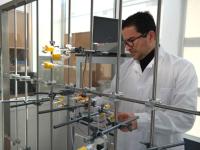Lignin as the Petroleum of the Future or Modern Alchemy
“We do not see waste as a problem but as a solution”, says Prof. Juan Carlos Colmenares, Ph.D. from the Institute of Physical Chemistry, Polish Academy of Sciences. In the face of enormous pollution and traditional sources of energy running thin, that kind of approach seems a panacea for those problems. But is it possible to produce fuel from lignin?
In cooperation with the Warsaw University of Technology and the University of Cordoba, a team of researchers from the Institute of Physical Chemistry, Polish Academy of Sciences, headed by Prof. Joan Carlos Colmenares, Ph.D. are working on a photocatalyst which is intended to transform lignin into valuable compounds, among other things into fuel or products for the synthesis of medicines and perfume manufacturing.
Streets are Paved with Fuel
Lignin is a black, slimy and very unpleasantly smelling liquid. In nature, it is found in wood to lend rigidity. It is the main by-product in the paper industry. Currently, the only common way of utilising lignin is to burn it as low-quality fuel.
Lignin is a natural polymer with a very complex 3D structure. It is formed of a number of aromatic compounds derivatives, including various types of phenyl alcohol. Its chemical composition and percentage in wood (usually from 10 to 40 pc.) depends on the tree species.
Currently, the global resources of lignin are 300 billion tons (with an annual increase of 20 billion tons) and exceed even petroleum resources (estimated at 230 billion tons). However, this wealth is not fully exploited. It may be this research conducted under supervision of Prof. Juan Carlos Colmenares that will result in the development of a technology serving this purpose.
Intelligent Photocatalysts
The transformation of lignin into a specific processable chemical compound is not easy for a number of reasons.
The chemical composition of lignin differs not only depending on the plant from which it comes, but also on the country and conditions in which the plant grew. Hence, it is very difficult to develop a technology which would be universal for each type of lignin. It is actually impossible. Therefore, the first stage boils down to a detailed characteristics of a particular kind of lignin.
Having chosen a model compound representing the complex structures of lignin, the researchers investigated the influence that selected photocatalysts exerted on lignin. Employees of the Faculty of Materials Science and Engineering at the Warsaw University of Technology supervised by Prof. Krzysztof Kurzydłowski, Ph.D. offered tremendous help at this stage. Using advanced research techniques, they prepared a detailed characteristics of the physical and chemical parameters of the new photocatalysts.
It is of paramount importance that these photocatalysts should not cause the total decomposition of lignin, they only should shorten its chains to the length that the researchers want. The photocatalysts are to be almost programmed to produce specific compounds. “We want to give intelligence and awareness to our materials”, says Prof. Colmenares.
Scientists from the University of Cordoba, supervised by Prof. Rafael Luque, helped develop the new photocatalysts. Also, titanium dioxide - TiO2- is to help in the transformation of lignin into valuable semi-products. However, it has to be placed on an appropriate medium. Sometimes on nanocomposites containing ferric oxide Fe2O3, sometimes – on zeolites (silicates) with a small addition of iron.
From Waste to a Valuable Compound
In the course of research conducted by the Polish Academy of Sciences, model lignin and a photocatalyst were exposed to ultraviolet light under normal atmospheric pressure and at the temperature of about 30 degrees Celsius. Therefore, conditions present in sunny places were thus reproduced. It turned out that both catalysts managed to convert benzyl alcohol from lignin to benzaldehyde in a very efficient way. This substance is used for the production of dyes and in the perfume industry.
Facilities transforming lignin into fuel can be called biorefineries. This is how the process of transforming lignin into valuable semi-products could be described: lignin in a container would be exposed to natural light, which would activate a catalyst which would transform lignin into desirable compounds.
All that would happen in natural conditions. “If we manage to combine the sun, a photocatalyst and lignin, we will create natural compounds and there will be no waste and environmental pollution”, explains Prof. Colmenares from the Institute of Physical Chemistry, Polish Academy of Sciences.
A Race against Time
Foreign scientists are also working on similar technologies. One day, the resources of petroleum will be exhausted and it is for this moment that we need a finished technology, which will successfully replace conventional sources of energy. Scandinavians are already importing lignin from South America. Prof. Juan Carlos Colmenares from the Institute of Physical Chemistry, Polish Academy of Sciences emphasises that the development of a technology transforming lignin into valuable compounds may take as long as 10 years of intensive research supported by sufficient funding and cooperation between scientific centres.
We are able to produce important and valuable things in Poland and I hope that together with the Warsaw University of Technology we will succeed in the development of a revolutionary technology”, Prof. Juan Carlos Colmenares sums up.
Monika Bukowska
Office for Promotion and Information








